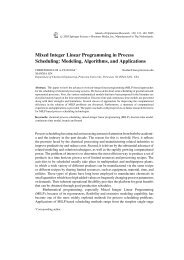Conceptual framework: What do you think is going on?
Conceptual framework: What do you think is going on?
Conceptual framework: What do you think is going on?
You also want an ePaper? Increase the reach of your titles
YUMPU automatically turns print PDFs into web optimized ePapers that Google loves.
03-Maxwell.qxd 10/1/2004 3:13 PM Page 44<br />
44 QUALITATIVE RESEARCH DESIGN<br />
EXAMPLE 3.3<br />
Using Ex<str<strong>on</strong>g>is</str<strong>on</strong>g>ting Theory<br />
Eliot Freids<strong>on</strong>’s book Doctoring Together: A Study of Professi<strong>on</strong>al Social<br />
C<strong>on</strong>trol (1975) <str<strong>on</strong>g>is</str<strong>on</strong>g> an account of h<str<strong>on</strong>g>is</str<strong>on</strong>g> research in a medical group practice,<br />
trying to understand how the physicians and admin<str<strong>on</strong>g>is</str<strong>on</strong>g>trators he studied identified<br />
and dealt with violati<strong>on</strong>s of professi<strong>on</strong>al norms. In c<strong>on</strong>ceptualizing<br />
what was <str<strong>on</strong>g>going</str<strong>on</strong>g> <strong>on</strong> in th<str<strong>on</strong>g>is</str<strong>on</strong>g> practice, he used three broad theories of the social<br />
organizati<strong>on</strong> and c<strong>on</strong>trol of work. He referred to these as the entrepreneurial,<br />
or physician-merchant, model, deriving from the work of Adam Smith;<br />
the bureaucratic, or physician-official, model, deriving to a substantial extent<br />
from Max Weber; and the professi<strong>on</strong>al, or physician-craftsman, model,<br />
which has been less clearly c<strong>on</strong>ceptualized and identified than the others. He<br />
showed how all three theories provide insight into the day-to-day work of the<br />
group he studied, and he drew far-ranging implicati<strong>on</strong>s for public policy<br />
from h<str<strong>on</strong>g>is</str<strong>on</strong>g> results.<br />
Freids<strong>on</strong> also used ex<str<strong>on</strong>g>is</str<strong>on</strong>g>ting theory in a more focused (and unexpected)<br />
way to illuminate the results of h<str<strong>on</strong>g>is</str<strong>on</strong>g> research. He argued that the social<br />
norms held by the physicians he studied allowed c<strong>on</strong>siderable differences<br />
of opini<strong>on</strong> about both the technical standards of work performance and<br />
the best way to deal with patients. These norms “limited the critical evaluati<strong>on</strong><br />
of colleagues’ work and d<str<strong>on</strong>g>is</str<strong>on</strong>g>couraged the expressi<strong>on</strong> of critic<str<strong>on</strong>g>is</str<strong>on</strong>g>m”<br />
(p. 241). However, the norms also str<strong>on</strong>gly opposed any outside c<strong>on</strong>trol<br />
of the physicians’ practice, defining physicians as the <strong>on</strong>ly <strong>on</strong>es capable<br />
of judging medical work. “The professi<strong>on</strong>al was treated as an individual<br />
free to follow h<str<strong>on</strong>g>is</str<strong>on</strong>g> own judgment without c<strong>on</strong>straint, so l<strong>on</strong>g as h<str<strong>on</strong>g>is</str<strong>on</strong>g> behavior<br />
was short of blatant or gross deficiencies in performance and inc<strong>on</strong>venience<br />
to colleagues” (p. 241). Freids<strong>on</strong> c<strong>on</strong>tinued:<br />
Th<str<strong>on</strong>g>is</str<strong>on</strong>g> <str<strong>on</strong>g>is</str<strong>on</strong>g> a very special kind of community that, structurally and normatively,<br />
parallels that described by Jesse R. Pitts as the “delinquent community” of<br />
French schoolchildren in particular and French collectivities in general during<br />
the first half of the twentieth century. ...Its norms and practice were<br />
such as to both draw all members together defensively against the outside<br />
world...and, internally, to allow each h<str<strong>on</strong>g>is</str<strong>on</strong>g> free<str<strong>on</strong>g>do</str<strong>on</strong>g>m to act as he willed.<br />
(pp. 243–244)<br />
He presented striking similarities between the medical practice he studied<br />
and the French peer group structure identified by Pitts. He coined the<br />
phrase “professi<strong>on</strong>al delinquent community” to refer to professi<strong>on</strong>al<br />
groups such as the <strong>on</strong>e he described, and used Pitts’s theory to illuminate<br />
the process by which th<str<strong>on</strong>g>is</str<strong>on</strong>g> sort of community develops and pers<str<strong>on</strong>g>is</str<strong>on</strong>g>ts.
















